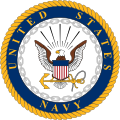| Naval Base Lingayen | |
|---|---|
| Lingayen Gulf, Luzon, Philippines | |
 Lingayen Gulf with landing spots January 1945 | |
| Site information | |
| Type | Naval base |
| Operator | |
| Location | |
 | |
| Coordinates | 16°17′N120°12′E / 16.283°N 120.200°E |
| Site history | |
| Built | 1945 |





Naval Base Lingayen was a United States Navy base built during World War II at Lingayen Gulf on the northwestern Island of Luzon in the Philippines. The base was founded after the Invasion of Lingayen Gulf on January 9, 1945, at Lingayen city and the surrounding gulf. The Naval base was used to support the later operations at Manila and the rest of Luzon Island and then at Okinawa. Lingayen Gulf offered excellent fleet anchorage. [1]


















